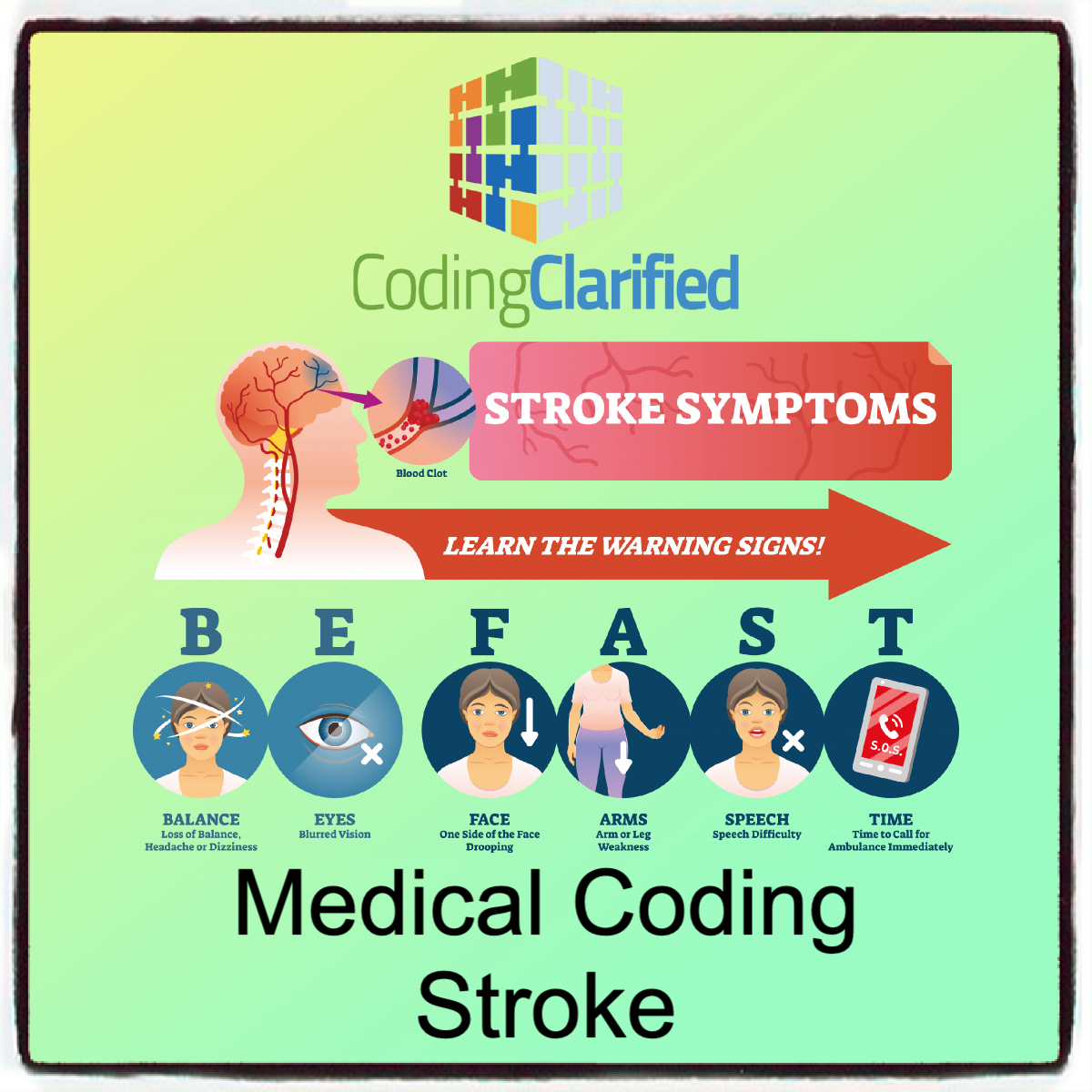Medical Coding and Billing Guidelines for Strokes
Medical Coding for a Stroke, a medical emergency with significant consequences, requires precise and accurate coding for proper billing and reimbursement. The complexity of stroke-related diagnoses—ranging from transient ischemic attacks (TIAs) to various types of strokes—demands healthcare providers and coders be familiar with the current coding standards, including ICD-10-CM (International Classification of Diseases, 10th Revision, Clinical Modification) codes and relevant procedural codes.
This article outlines the coding and billing guidelines for strokes, covering essential considerations, important codes, and best practices for healthcare professionals.
Understanding Stroke Types and Definitions
The first step in accurate stroke coding is understanding the types of strokes and related conditions:
- Ischemic Stroke (Cerebral Infarction): Occurs when a blood clot blocks or narrows an artery leading to the brain, resulting in reduced blood flow and tissue death.
- Hemorrhagic Stroke: Involves the rupture of a blood vessel, leading to bleeding in or around the brain.
- Transient Ischemic Attack (TIA): Often referred to as a “mini-stroke,” a TIA is a temporary blockage of blood flow that does not cause permanent damage.
- Cerebral Venous Sinus Thrombosis (CVST): A rare type of stroke caused by a blood clot in the brain’s venous sinuses.
- Subarachnoid Hemorrhage (SAH): A type of hemorrhagic stroke characterized by bleeding in the area between the brain and the thin tissues covering it.
ICD-10-CM Codes for Stroke Diagnosis
ICD-10-CM provides detailed codes for various types of strokes and related conditions. It’s important to use the most accurate code based on the type and severity of the stroke, as well as the patient’s specific condition.
Ischemic Stroke
- I63.0 – Cerebral infarction due to thrombosis of cerebral arteries
- I63.1 – Cerebral infarction due to embolism of cerebral arteries
- I63.9 – Cerebral infarction, unspecified
Hemorrhagic Stroke
- I61.0 – Non-traumatic subarachnoid hemorrhage
- I61.9 – Cerebral hemorrhage, unspecified
- I62.9 – Hemorrhage of brain, unspecified
Transient Ischemic Attack (TIA)
- G45.0 – TIA with complete resolution of symptoms
- G45.1 – TIA with residual symptoms
Cerebral Venous Sinus Thrombosis (CVST)
- I67.6 – Cerebral venous thrombosis
Coding for Stroke Sequelae (Aftereffects)
Stroke survivors often experience long-term consequences such as hemiplegia, dysphagia, and aphasia. These sequelae must be coded appropriately. Some examples include:
- G81.9 – Hemiplegia, unspecified
- I69.351 – Sequelae of ischemic stroke with right hemiplegia
- I69.820 – Sequelae of cerebrovascular disease, unspecified
Post-Stroke Cognitive Deficits
F01.50 – Vascular dementia without behavioral disturbance (when the cognitive decline follows a stroke).
Medical Coding for Strokes Documentation Requirements
Accurate stroke coding relies heavily on detailed documentation. To ensure proper reimbursement and avoid claim denials, providers should document the following elements:
- Type of Stroke: Ischemic, hemorrhagic, or other specific types
- Location of Stroke: Indicate the cerebral vessel or brain area affected
- Laterality: Left, right, or bilateral involvement
- Severity: Acute, chronic, or sequelae
- Duration of Symptoms: Especially for TIAs, noting whether symptoms resolve fully or partially
- Risk Factors: Hypertension, diabetes, atrial fibrillation, and other risk factors should be documented to support the diagnosis and severity.
Example of Proper Documentation:
“Acute ischemic stroke of the right middle cerebral artery, with significant motor deficits in the left upper and lower extremities.”
Billing for Stroke Treatment and Services
When it comes to billing for stroke care, different services may be involved, including diagnostic imaging, emergency room visits, inpatient admissions, and post-stroke rehabilitation. Billing should accurately reflect the services provided, using the correct CPT codes.
Common CPT Codes for Stroke-Related Services:
- CPT 70450 – CT scan of the head (without contrast)
- CPT 70551 – MRI of the brain (with or without contrast)
- CPT 99291 – Critical care, first 30 minutes (for acute stroke care in the ICU)
- CPT 99468 – Neonatal or pediatric critical care, initial day (if stroke occurs in neonates or children)
- CPT 92227 – Electroretinography (used if there are vision-related sequelae from the stroke)
Stroke Rehabilitation Codes:
For patients requiring rehabilitation after a stroke, the following codes may apply:
- CPT 97110 – Therapeutic exercises to develop strength and endurance
- CPT 97530 – Therapeutic activities to improve functional performance
- CPT 97799 – Unlisted physical medicine/rehabilitation service or procedure
Tips for Accurate Medical Coding for Stroke and Billing
To ensure accurate coding and optimal reimbursement, healthcare providers and coders should follow these best practices:
- Use Specific Codes: Always select the most specific code available, including the type of stroke, location, and other details.
- Understand the Differences Between Ischemic and Hemorrhagic Stroke: These conditions require different codes, so it’s essential to determine whether a stroke is ischemic or hemorrhagic.
- Include Sequelae Codes When Necessary: Sequelae or long-term effects of a stroke (e.g., paralysis, aphasia) should be coded alongside the acute condition.
- Verify Laterality: Document whether the stroke affected the left or right side of the brain, as this impacts coding.
- Document Comorbidities: Stroke often occurs in patients with other chronic conditions like hypertension or diabetes, which can affect the treatment approach and need to be documented and coded accordingly.
- Ensure Appropriate ICD-10-CM Sequencing: The primary diagnosis should always reflect the acute condition or sequelae, and any other coexisting conditions should be listed as secondary diagnoses.
- Monitor Updated Codes: The ICD-10-CM and CPT coding systems are updated annually, so coders should keep current with any new or revised codes that may impact stroke billing.
Accurate coding and billing for strokes are critical for proper reimbursement and ensuring the continuity of care for patients. Understanding the different types of strokes, the specific ICD-10 codes, and the appropriate billing procedures is essential for both healthcare providers and medical coders. By following the guidelines provided here and maintaining clear and thorough documentation, healthcare providers can ensure that stroke patients receive the appropriate care while maximizing reimbursement and minimizing the risk of claim denials.
Learn more about strokes here: https://www.hopkinsmedicine.org/health/conditions-and-diseases/stroke#:~:text=A%20stroke%20can%20happen%20to,even%20more%20damage%20and%20irritation.
Let Coding Clarified ‘clarify” coding for you.

